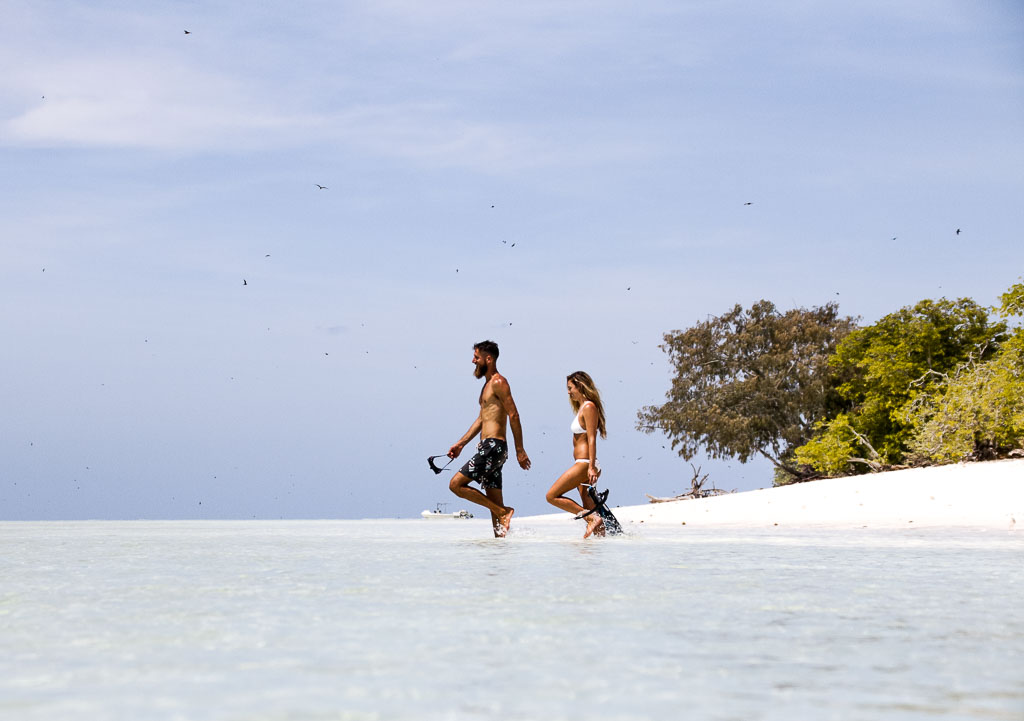The Great Barrier Reef is not just a place on a map; it’s a living and thriving ecosystem made up of billions of organisms and home to over 900 islands and coral cays. Just 75 kilometres off of Gladstone, Queensland, lies the Capricorn Bunker Group- the southernmost part of the Great Barrier Reef consisting of eight biologically diverse, and exceptionally beautiful islands that are just a stone’s throw away from the mainland. As we boarded the boat headed to North West Island, this tiny strip of land that we would be living and camping on for the next 7 days, with our two cars worth of gear, boards and leisurely essentials (apparently, we packed light) we had little idea of what we’d be in for.
Under the stars. Our North West odyssey.
Australia, you're so wild and free.
@danwilly and @indhi_ mid rapturous-delight in @willandbear
There’s just something about being in the open sea, with the wind on your face and a fine salty glaze glistening across your body. Watching the swell ease its way down the horizon, those gentle rolls that never cease to halt. Curtis Ferry Services have been dropping people out to North West, and the islands sprawled across the Capricorn Bunker region for the past 40 years. The trip out there is something in itself.
The first night we were there, our camp nestled amongst the Pisonia trees and only 20 steps from the soft sand, with those mesmerisingly translucent waters of the lagoon that shone the colour of a Moroccan gem. We were greeted with a warm cacophony from some of the islands local residents- Knoddy turn and Shearwater (Mutton) birds. Muttons are ever so graceful at sea, soaring freely across the high seas, but on land, well lets just say that’s another story. They nest and burrow under the Pisonia trees throughout the island, their rudimentary singing calls attempting to serenade us throughout the night- with little avail haha.
The walk out to the reef // just a step off from the high reef edge into an oasis of large pelagic fish and corals.
Dinner done right. @micklatt @_sophiaanne_ @danwilly
Back in 1904, the island was actually used as the base for a turtle soup factory- the boilers still remain, in their rusted form today. The history of some of The Great Barrier Reef’s islands are flagrantly barbaric as much as they are intriguing. The turtles were caught, killed, butchered, ‘souped’, tinned and exported- the whole operation completed from sea to soup. It wasn't until 1950 that sea turtles became protected animals (thank god- I can’t imagine turtle soup being very appetising anyhow).
The days on the island consisted of waking up with the sun, that soft glow that slowly emanates its way through the trees and onto the side where we were camped. Stepping onto the beach is like witnessing the sands of time- every 5 metres or so there’s a new animal track lingering from the low tide and up into the soft sand of the foredune. Turtles. These guys come here to lay their eggs, swimming in after dusk on the low tide and leaving early the next morning before the predators lurk in the high water of the lagoon. Michael, one of the guys on the trip, has been doing turtle conservation work for the past few years- we counted 420 tracks encompassing the island in just the first night alone. 420- that’s wild man!
Slacklining and hammock hangs part of the daily rituals of island life.
Watching the baby turtles make their way to the water. Pretty special moments in time.
@danwilly braving the sharkies for the shot. North West is the largest coral cay in the Capricorn-Bunker region, you can meander around it in under an hour.
Absolute ledgie @_sophiaanne_ enjoying the afternoon sun.
The abundance of marine and wildlife on the island is actually phenomenal. From the turtles laying their eggs on the beach to the Manta rays and small reef sharks swimming in the lagoon. One afternoon we were eating our stuffed spuds whilst watching the sun go down- the spuds filled with the previous night’s leftovers and marinated veggies (recommended easy and seriously delicious camp meal), enjoying the tranquillity of our surroundings and a cold bev, when all of a sudden about ninety loggerhead turtle hatchlings erupted from the dune behind us and came scurrying down between our toes in dire desperation to reach the waters edge. This was not a rare occurrence. In fact, after seven days, we had possibly become turtled out.
Australia seriously has so much to offer, it’s a country that’s beautifully wild and free. We yearn to visit those places overseas and tropical islands far out of our reach, but in reality, the best destinations and experiences are right here in our own backyard. North West Island, you were a real gem.
This article was featured on Summersite












